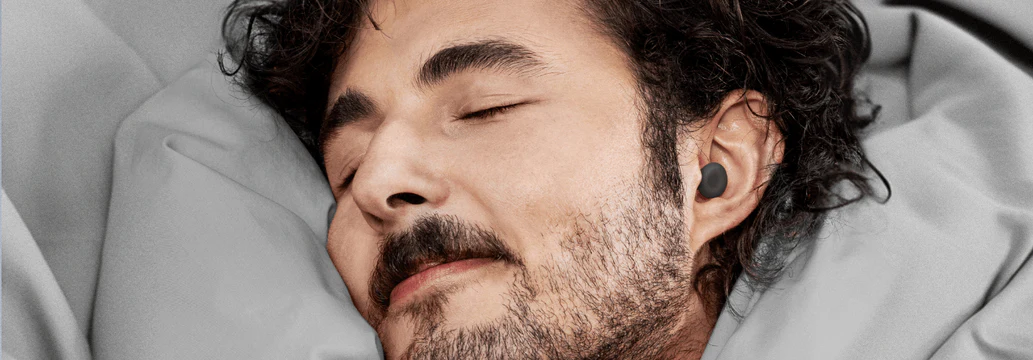It’s a popular tool, but why does white noise help you sleep? And what are the benefits? Let’s take a look at everything you need to know about white noise and sleep – you’ll soon be on your way to a more restful night.
Key takeaways
- White noise is a mixture of sound frequencies played together at an equal intensity to create a noise that can drown out background noise
- Pink noise and brown noise work in a similar way, but create slightly different sounds that you may prefer
- All of these noises may be beneficial when it comes to getting a better night’s sleep and improving your focus and concentration
- It’s important to listen to white noise at a low level, as sustained exposure to loud noises can damage your hearing

What is white noise?
Let’s start at the beginning. According to the Mirriam-Webster Dictionary, there are two white noise meanings:
- An even mixture of sound waves extending over a wide frequency range
- A constant background noise, especially one that drowns out other sounds
But what does that mean in terms we can actually understand? Well, basically, white noise is a steady, ambient sound that can mask background noise that blends all audible frequencies together, creating a soothing, steady hum.
That’s why so many people use white noise to fall asleep. By masking background noises like traffic and loud neighbors, white noise can promote relaxation and help to maintain focus during light sleep stages, meaning you fall asleep faster. It also reduces disturbances throughout the night, helping you to stay asleep longer, and enjoy a better quality of sleep.
How does white noise work?
Let’s go into more detail about the mechanisms of white noise. The term ‘white noise’ refers to a particular noise that contains all of the frequencies of sound that the human ear can hear. That means all frequencies between 20 hertz and 20,000 hertz. They’re all played together at an equal intensity, to create a hissing, whirring or ‘shhh’ noise that’s sometimes described as being similar to TV static. It’s also similar to the noise an untuned radio makes, as well as a hairdryer, a vacuum cleaner, or the sound of an air conditioner.
When there are one or two sounds, your brain can pick them out. That’s a good thing when you’re having a conversation with friends or trying to focus on a presentation at work. But it becomes a problem when you’re lying in bed and can’t focus on anything.
However, when you mix many sounds together, as in the case of white noise, it suddenly becomes difficult for your brain to pick out any one noise in particular. One small study found that white noise helped patients in a hospital intensive care unit to sleep better because it reduced “the difference between background noise and peak noise”. They also found that the sleep quality of the patients experiencing both ICU noise and white noise was comparable to sleep quality with no noise present.
Because your brain can't hone in on any one sound, it means your brain can relax, without trying to focus on an individual sound – and you may end up getting a better night’s sleep.
The benefits of white noise for sleep
The primary benefit of white noise is that it helps to mask other noises that may be distracting. If you have trouble sleeping, then it’s worth giving white noise a try to see if it works for you, particularly if you’re a light sleeper or live in a noisy area.
It can also help you to fall asleep faster. Indeed, one study found that participants fell asleep 38% faster when listening to white noise compared to when they were simply exposed to normal environmental noise.
Getting to sleep is one thing, but managing to stay asleep throughout the night is another matter entirely. Poor sleep quality is bad news all round. It’s associated with increased stress, depression, anxiety, poorer mental function, and much more. The World Health Organization (WHO) estimates that 25% of people suffer from disturbed sleep due to environmental noise.
If you’re one of those 25%, white noise could be the solution! One study found that the use of white noise significantly improved sleep in participants who previously complained about having trouble sleeping due to environmental noise factors – and the study was carried out in New York, surely one of the world’s noisiest cities!
Potential downsides of using white noise to fall asleep
Is white noise good for sleep? Well, there are, of course, always two sides to every story. When it comes to white noise to help sleep, there are some experts who suggest that it may do more harm than good. The main concern is that, while using white noise as a sleep aid may help you to drift off faster, it may not allow your auditory system to fully shut down overnight.
Another issue is that white noise could impact your auditory system’s ability to function, over time. One study found that when used for long periods of time for sleep or for managing tinnitus, white noise can impair the central auditory system in the brain. It found that white noise can make the brain less sensitive to individual sounds over time, meaning that the brain may end up finding it more difficult to block our irrelevant sounds and we might find it harder to focus on particular sounds when it’s noisy, like trying to have a conversation when there is a lot of background noise.
Types of white noise and devices available
Some researchers actually recommend using pink noise or brown noise instead of white noise. Like white noise, pink noise is a combination of different noises from across the sound spectrum, containing all frequencies between 20 Hz and 20,000 Hz. However, it reduces the power of sounds at higher frequencies and increases the power of sounds at lower frequencies to create a more even sound.
Brown noise – also called red noise – works in a similar way to both white and pink noise, but low-frequency sounds are more intense than in the other two types of noise. Most of the higher frequencies that can make white noise sound harsh, or distracting for some people, are removed. That results in a sound that’s more pleasant to listen to.
There are a few different ways you can listen to all three types of noise, most commonly by using a white noise machine or by listening on an app.

Earplugs as an alternative or complement to white noise
So, does white noise help you sleep? It can do – but if you prefer silence or need additional sound reduction, earplugs are a great addition to your sleep toolkit.
Earplugs like Loop Dream™ are specifically designed for sleep. They offer our most powerful noise reduction of 27 dB (SNR), reducing the noises that keep you up at night. Every feature of these earplugs is designed to maximise sleep comfort, made with our softest silicone and an innovative earplug body that reduces pressure on the ear – even for side sleepers. Additionally, the new hybrid memory foam-silicone ear tips follow the natural shape of your ears for even more comfort. You might even find that you can fall asleep with the earplugs alone, and don’t need to use white noise after all.
How to incorporate white noise or earplugs into your sleep routine
If you want to use sounds to help you fall asleep, here are our top tips for making it work for you:
- Opt for a machine or phone app with adjustable volume and noise options (it’s good to be able to choose between white, pink, or brown noise).
- Keep the volume at a moderate level, ideally below 50 decibels, to avoid damaging your hearing.
- Try different sounds, like rain or ocean waves to see which suits you best. Some people find deeper tones like brown noise more soothing.
- Many machines or apps allow you to set timers, so the noise turns off automatically once you’re asleep.
- Position the machine a few feet away from your bed to reduce your direct noise exposure.
- If external noise is too loud, combine white noise with earplugs for maximum effect.
Finding your ideal sleep sound solution
White noise and earplugs are powerful tools for improving sleep quality. White noise creates a steady sound that masks noise from your environment, while earplugs reduce noise levels. Everyone’s different, so it’s best to try different options to find out what works best for you.

How to go to sleep faster
We’ve put together a list of eight tips on how to sleep faster so that you can finally doze off and get some well-ear...

What To Look For In Noise Reduction Earplugs
Unlock expert tips for choosing the perfect noise-reduction earplugs! Discover key features to consider when choosing...

How To Stay Focused At Work and Improve Concentration
Having trouble concentrating whilst in a bustling office? Discover our top tips for staying focused at work so you ca...



















